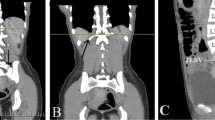Abstract
Purpose
Pelvic incidence angle is not always measurable due to lumbosacral transitional vertebrae (LSV). The fifth lumbar vertebra (L5) is rarely abnormal. The purpose of this study was to quantify from full-body standing X-rays, the L5 incidence angle (L5I) in a normal asymptomatic population and to correlate it with standard spino-pelvic parameters taking the sacrum (S1) as a reference.
Methods
One hundred and forty seven asymptomatic volunteers were enrolled. The ethics committee approved the study protocol. Subjects underwent a low-dose full spine X-ray. 3D reconstructions were obtained and L5I was measured using the upper L5 endplate as the reference instead of the S1 endplate. A group of subjects with LSV was identified and subdivided in two subgroups. Standard spino-pelvic parameters and normative values for the L5 parameters were obtained. Statistical correlations were calculated between the standard and L5 parameters as well as L5I with L1–L5 lordosis in both subgroups.
Results
Twenty two (14.96 %) subjects with LSV were found. Ten of these had an unidentifiable S1 endplate due to a sacralisation of L5. Mean values for the L5I, L5 tilt, L5 slope and L1–L5 lordosis were, respectively, 22.43, 4.65, 17.73, and 45.51 for normal subjects (N = 137) and 32.75, 6.63, 26.38, and 55.02 for sacralisation of L5 subjects (N = 10). Mathematical relationship found: L5I = 0.7641 * PI − 17.725 (R = 0.83) and L1–L5 = 0.67 * L5I + 30.7 (R = 0.64).
Conclusion
This prospective study is first to provide normative spino-pelvic values at the L5 level in an asymptomatic population, particularly in case of (LSV) sacralisation of L5 (N = 10) where L5I and L1–L5 lordosis appears to be 10° more important than in normal population. We propose L5I as a new spino-pelvic parameter to restore in case of L5-S1 disk disease. These normative values will help to control peri-operatively the adequate lordosis restoration, in the presence of LSV.







Similar content being viewed by others
References
Le Huec JC, Roussouly P (2011) Sagittal spino-pelvic balance is a crucial analysis for normal and degenerative spine. Eur Spine J 20:556–557. doi:10.1007/s00586-011-1943-y
Duval-Beaupère G, Schmidt C, Cosson P (1992) A barycentremetric study of the sagittal shape of spine and pelvis: the conditions required for an economic standing position. Ann Biomed Eng 20:451–462
Legaye J, Duval-Beaupère G, Hecquet J, Marty C (1998) Pelvic incidence: a fundamental pelvic parameter for three-dimensional regulation of spinal sagittal curves. Eur Spine J 7:99–103
Roussouly P, Berthonnaud E, Dimnet J (2003) Geometrical and mechanical analysis of lumbar lordosis in an asymptomatic population: proposed classification. Rev Chir Orthop Reparatrice Appar Mot 89:632–639
Roussouly P, Gollogly S, Berthonnaud E, Dimnet J (2005) Classification of the normal variation in the sagittal alignment of the human lumbar spine and pelvis in the standing position. Spine 30:346–353
Boulay C, Tardieu C, Hecquet J et al (2005) Sagittal alignment of spine and pelvis regulated by pelvic incidence: standard values and prediction of lordosis. Eur Spine J 15:415–422. doi:10.1007/s00586-005-0984-5
Roussouly P, Pinheiro-Franco JL (2011) Sagittal parameters of the spine: biomechanical approach. Eur Spine J 20:578–585. doi:10.1007/s00586-011-1924-1
Apazidis A, Ricart PA, Diefenbach CM, Spivak JM (2011) The prevalence of transitional vertebrae in the lumbar spine. Spine J 11:858–862. doi:10.1016/j.spinee.2011.08.005
Mac-Thiong J-M, Roussouly P, Berthonnaud E, Guigui P (2010) Sagittal Parameters of Global Spinal Balance. Spine 35:E1193–E1198. doi:10.1097/BRS.0b013e3181e50808
Morvan G, Mathieu P, Vuillemin V et al (2011) Standardized way for imaging of the sagittal spinal balance. Eur Spine J 20:602–608. doi:10.1007/s00586-011-1927-y
Carreau JH, Bastrom T, Petcharaporn M et al (2014) Computer-generated, three-dimensional spine model from biplanar radiographs: a validity study in idiopathic scoliosis curves greater than 50 degrees. Spine Deformity 2:81–88. doi:10.1016/j.jspd.2013.10.003
Humbert L, De Guise JA, Aubert B et al (2009) 3D reconstruction of the spine from biplanar X-rays using parametric models based on transversal and longitudinal inferences. Med Eng Phys 31:681–687. doi:10.1016/j.medengphy.2009.01.003
Kuntz C4, Levin LS, Ondra SL, et al. (2007) Neutral upright sagittal spinal alignment from the occiput to the pelvis in asymptomatic adults: a review and resynthesis of the literature. J Neurosurg Spine 6:104–112. doi: 10.3171/spi.2007.6.2.104
Barrey C (2004) Equilibre sagittal pelvi-rachidien et pathologies lombaires dégénératives: etude comparative à propos de 100 cas [these]. Université Claude Bernard, Lyon
Farshad M, Aichmair A, Hughes AP et al (2013) A reliable measurement for identifying a lumbosacral transitional vertebra with a solid bony bridge on a single-slice midsagittal MRI or plain lateral radiograph. Bone Joint J 95-B:1533–1537. doi:10.1302/0301-620X.95B11.32331
Labelle H, Roussouly P, Berthonnaud E et al (2005) The importance of spino-pelvic balance in L5-S1 developmental spondylolisthesis: a review of pertinent radiologic measurements. Spine 30:S27–34
Author information
Authors and Affiliations
Corresponding author
Ethics declarations
Conflict of interest
None.
Rights and permissions
About this article
Cite this article
Dominguez, D., Faundez, A., Demezon, H. et al. Normative values for the L5 incidence in a subgroup of transitional anomalies extracted from 147 asymptomatic subjects. Eur Spine J 25, 3602–3607 (2016). https://doi.org/10.1007/s00586-015-4371-6
Received:
Revised:
Accepted:
Published:
Issue Date:
DOI: https://doi.org/10.1007/s00586-015-4371-6




